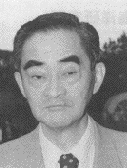Click on home button to open mainpage
 Dr. Eiichi Goto papers hardware software
|
Japan, 1954
GeneralThe PC-1 (Parametron Computer 1) is developed at the Professor Hidetosi Takahasi's Laboratory of the Department of Physics, University of Tokyo, in March 1958. The Parametron is invented by Dr. Eiichi Goto while being a post graduate school student in 1954. The Parametron is cheap and reliable, and in use widely in Japan. But it becomes defeated by the transistor based computers because of the much higher speed. The PC-1 is a binary, single-address computer using a Parametron with magnetic core memory. Its architecture is based on the EDSAC computer, but its instruction set or instruction format is very different and more advanced. The PC-1 is famous for its initial order - also known as bootstrap (ed.) - which installs via a program on a paper tape written in symbols into the memory. (3) It took charge of decimal to binary conversion, code conversion, the process of relative and absolute address, and so on in only 68 words. The PC-1 bootstrap is undoubtedly one of the masterpieces of computer programs in the world. It is worth to have a look at it.
Principle of ParametronThe principle of the Parametron is invented by Dr. Eiich
Goto(2) in 1954 and is based on the phase of an oscillation where a
constant cycle is generated. What Goto did was to build a circuitry based on that idea, and by joining a number of such circuits one could build logical modules acting like AND - OR XOR etc. Because of the much simpler construction the Parametron
computer was much more stable than the western machines with valves and transistors.
Machines build that way are also much cheaper. However development does continue in universities when we may believe the various web pages. Specifications
|
![]()
| Last Updated on 29 September 2000 | For suggestions please mail the editors |
Footnotes & References
| 1 | by K F Loe & E Goto (Tokyo) |
| 2 | A New Concept in Computing, by R. L Wigington, Proceedings of the IRE, April 1959, Vol 47, No 4, page 516-523. |
| 3 | This is probably one of the first Operating Systems. (ed.) |